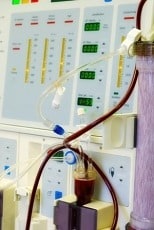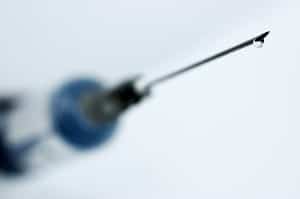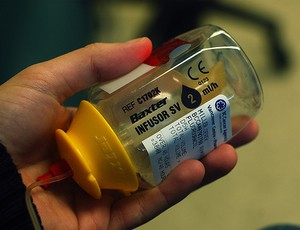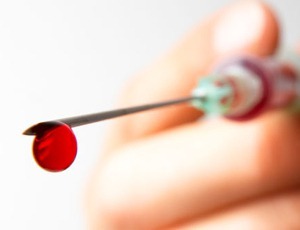Vascular access placement in patients with chronic kidney disease

The majority of incident hemodialysis (HD) patients initiate dialysis via catheters. We sought to identify factors associated with initiating hemodialysis with a functioning arterio-venous (AV) access” Goel et al (2017). Abstract: BACKGROUND: The majority of incident hemodialysis (HD) patients initiate dialysis via catheters. We sought to identify factors associated with initiating hemodialysis with a functioning […]
Platelets play a crucial role in vascular access thrombus formation

After stenosis of arteriovenous vascular access in hemodialysis patients, platelets play a crucial role in subsequent thrombus formation, leading to access failure” Shin et al (2017). Abstract: After stenosis of arteriovenous vascular access in hemodialysis patients, platelets play a crucial role in subsequent thrombus formation, leading to access failure. In a previous study, the mean […]
Analysis of needlestick injuries over a 10 year period

Here we investigated needlestick and similar injuries reported over a 10-year period between April 2004 and March 2014. The purpose of this study was to prevent recurrence and reduce the incidence of such injuries at Tokyo Dental College Chiba Hospital” Morinaga et al (2016). Abstract: Here we investigated needlestick and similar injuries reported over a […]
Review of invasive vascular access in severely injured patients
Important procedures may include placement of arterial lines and central venous catheters (CVCs). Knowledge of indication, performance and localization of invasive catheterisation of trauma care in Germany is scarce” Struck et al (2017). Abstract: BACKGROUND: The continuous monitoring of vital parameters and subsequent therapy belong to the core duties of anaesthetists during acute trauma resuscitation […]
Reducing the number of peripherally inserted central catheters inserted in infants

Our objective was to safely reduce the number of peripherally inserted central catheters (PICCs) inserted in infants with umbilical venous catheter using quality improvement methods” Vachharajani et al (2017). Abstract: OBJECTIVE: Our objective was to safely reduce the number of peripherally inserted central catheters (PICCs) inserted in infants with umbilical venous catheter using quality improvement […]
Umbilical venous catheter versus PICC in neonates

UVC is a cheaper alternative to PICC, with similar success rate, short-term complications and time needed for insertion” Dongara et al (2017). Abstract: OVERVIEW: Peripherally inserted central catheter (PICC) and umbilical venous catheter (UVC) in terms of success rate, complications, cost and time of insertion in neonatal intensive care were compared. Neonates requiring vascular access […]
Evaluation of the adsorption of filgrastim on infusion bag, line and filter

The purpose of the study was to evaluate the adsorption of filgrastim on infusion sets (comprising infusion bag, line and filter) and to compare the adsorption of the original filgrastim preparation with biosimilar preparations using HPLC” Tange et al (2017). Abstract: The purpose of the study was to evaluate the adsorption of filgrastim on infusion […]
Short incubation MALDI-TOF MS identification from positive blood cultures

Species identification by MALDI-TOF MS from shortly incubated subcultures resulted in adjustments of empiric antibiotic therapies and might improve the clinical outcome of septic patients” Köck et al (2017). Abstract: Background: Results of blood culture (BC) diagnostics should be swiftly available to guide treatment of critically ill patients. Conventional BC diagnostics usually performs species identification […]
Home parenteral nutrition and the incidence of CRBSI

This study aimed to illustrate how the use of different CRBSI definitions affects the reported incidence” Tribler et al (2017). Abstract: BACKGROUND: A common complication in patients receiving home parenteral nutrition (HPN) is catheter-related bloodstream infections (CRBSIs). The CRBSI incidence has been advocated as an outcome parameter assessing the quality of care. This study aimed […]
Music therapy and distraction cards as pain relief during phlebotomy in children

To investigate three different distraction methods (distraction cards, listening to music, and distraction cards + music) on pain and anxiety relief in children during phlebotomy” Aydin and Sahiner (2017). Abstract: AIM: To investigate three different distraction methods (distraction cards, listening to music, and distraction cards + music) on pain and anxiety relief in children during […]
Ultrasound and vascular access reviewed in this full text article
Vascular punctures are often necessary in critically ill patients. They are secure, but not free of complications. Ultrasonography enhances safety of the procedure by decreasing puncture attempts, complications and costs” Almeida (2016). Abstract: Vascular punctures are often necessary in critically ill patients. They are secure, but not free of complications. Ultrasonography enhances safety of the […]
Ethanol and heparin locking solution for CRBSI prevention in hemodialysis patients

Ethanol lock solution has been mainly administered in paediatric and home parenteral nutrition patients in order to prevent catheter related blood stream infections (CRBSI). Its utility in hemodialysis (HD) patients with non-tunneled-uncuffed catheter (NTC) has been poorly explored” Sofroniadou et al (2017). Abstract: Introduction: Ethanol lock solution has been mainly administered in paediatric and home […]
Case report describes isolated persistent left superior vena cava
The venous anomaly of a persistent left superior vena cava (PLSVC) affects 0.3%-0.5% of the general population. PLSVC with absent right superior vena cava, also termed as “isolated PLSVC,” is an extremely rare venous anomaly” Bisoyi et al (2017). Abstract: The venous anomaly of a persistent left superior vena cava (PLSVC) affects 0.3%-0.5% of the […]
Outcomes of arm implantable port placement reviewed
To prospectively evaluate the perioperative safety, early complications and satisfaction of patients who underwent the implantation of central catheters peripherally inserted via basilic vein” Fonseca et al (2016). Abstract: OBJECTIVE: To prospectively evaluate the perioperative safety, early complications and satisfaction of patients who underwent the implantation of central catheters peripherally inserted via basilic vein. [ctt […]
Intravenous medication administration error reduction

Errors made in the administration of intravenous medication can lead to catastrophic harm. The frequency of hospital settings in which medication pumps are being used are increasing. We sought to improve medication safety by implementing a 2-person verification system before medication administration” Subramanyam et al (2016). Abstract: OBJECTIVE: Errors made in the administration of intravenous […]
Weighing elastomeric pumps at home to determine infusion accuracy

With proper education, weighing Baxter Infusors at home with kitchen scales can be an accepted and objective alternative to the current recommendation of visual inspection” Cusano et al (2017). Abstract: Purpose: Elastomeric pumps are used to administer 46-hour infusions of 5-fluorouracil (5FU). Baxter suggests patients visually monitor their pumps to ensure that infusions are proceeding […]
Effectiveness of local anesthesia delivered via elastomeric pump
To assess the effectiveness of local anesthesia, delivered via elastomeric pump to manage pain in patients undergoing cardiothoracic surgery” Chopra et al (2017). Abstract: OBJECTIVE: To assess the effectiveness of local anesthesia, delivered via elastomeric pump to manage pain in patients undergoing cardiothoracic surgery. [ctt link=”cp1eY” template=”1″]ReTweet if useful… Effectiveness of local anesthesia delivered via […]
What is the extent of outpatient parenteral antibiotic therapy in Asia

We sought to elucidate the extent and nature of outpatient parenteral antibiotic therapy (OPAT) in Asia and to consider the ramifications and opportunities for improvement” Fisher et al (2017). Abstract: OBJECTIVES: Healthcare facilities internationally have grown outpatient parenteral antibiotic administration services for the last few decades. The literature contains publications from dozens of countries describing […]
BSAC UK OPAT working group investigate antimicrobial stability

Outpatient parenteral antimicrobial therapy (OPAT) is an established approach to patient care. A lack of data on antimicrobial stability within administration devices is a barrier to service expansion, and poses an antimicrobial stewardship dilemma” Jenkins et al (2017). Abstract: BACKGROUND: Outpatient parenteral antimicrobial therapy (OPAT) is an established approach to patient care. A lack of […]
Extent of bacterial growth in spiked intravenous fluids over an 8-hour period

This study demonstrated that LR IV bags do not support any bacterial growth for up to 8 hours after spiking” Haas et al (2017). Abstract: Protocol changes prompted by the Joint Commission mandating intravenous (IV) fluid bags to be used within 1 hour of spiking because of possible bacterial contamination have sparked clinical and econom- […]
Difference in reporting rates of bloodborne pathogen exposure

Employees in health care settings are at varying risk for bloodborne pathogen (BBP) exposures” Bush et al (2017). Abstract: Background: Employees in health care settings are at varying risk for bloodborne pathogen (BBP) exposures. We compared differences in reporting rates of BBP exposures among health care personnel during 2 different time periods, assessing job category, […]
What is the risk of sharps injuries among home care aides?

Objectives were to quantify risks of sharps injuries (SI) in a large HC aide population, compare risks between major occupational groups, and evaluate SI risk factors” Brouillette et al (2017). Abstract: Objectives: Home care (HC) aides constitute an essential, rapidly growing workforce. Technology advances are enabling complex medical care at home, including procedures requiring the […]
Promotion of hand hygiene practices is sustainable in a resource-constrained setting
Promotion of hand hygiene is feasible and sustainable in a resource-constrained setting using a multimodal improvement strategy” Pfäfflin et al (2017). Abstract: Background: The burden of health-care associated infections in low-income countries is high. Adequate hand hygiene is considered the most effective measure to reduce the transmission of nosocomial pathogens. We aimed to assess compliance […]
Implementation of a chlorhexidine gluconate bed bathing protocol

The objective of this study was to determine understanding of bed bathing practices over time after the implementation of a standardized bed bathing protocol” Reese et al (2017). Abstract: The objective of this study was to determine understanding of bed bathing practices over time after the implementation of a standardized bed bathing protocol. An online […]
Which is the best skin antiseptic solution before blood culture collection?

The rates of blood contamination were not different when isopropyl alcohol and chlorhexidine were compared. Isopropyl alcohol could be used for skin antisepsis before blood collection” Martínez et al (2017). Abstract: Background: False-positive blood cultures can lead to unnecessary risks and misuse of antibiotics; to reduce rates of false-positives, it would be useful to determine […]
Guidewire associated arrhythmia during central venous catheterization
During central venous catheterization through the right internal jugular vein, inserting guywires to depths of 15 or 17.5 cm before tissue dilation reduced the incidence of arrhythmic episodes compared to a depth of 20 cm” Lee et al (2017). Abstract: Objective: Guidewire-induced arrhythmias that occur during central venous catheterization can progress to malignant arrhythmias in rare cases. […]
Adequacy of antimicrobial therapy in patients with CLABSI

Our CLABSI patients had a high mortality, although antimicrobial therapy was appropriate. Gram-negative bacteria were responsible for almost half of the cases and there was a high rate of bacteria resistance to extended-spectrum antibiotics” Yokota et al (2016). Abstract: BACKGROUND: Central venous catheters are significant risk factors for bloodstream infection (BSI), which are directly associated […]
Study attempts to reduce the number of intravenous catheters inserted

This study aims to reduce the use of urinary and intravenous catheters with an inappropriate indication, and as a result reduce the catheter-related complications. If (cost-) effective it provides a tool for a nationwide approach to reduce catheter-related infections and other complications” Laan et al (2017). Abstract: BACKGROUND: Urinary and (peripheral and central) intravenous catheters […]
Choosing peripheral intravenous catheter for CT contrast injection
To compare the 24-gauge side-holes catheter and conventional 22-gauge end-hole catheter in terms of safety, injection pressure, and contrast enhancement on multi-detector computed tomography (MDCT)” Tamura et al (2017). Abstract: PURPOSE: To compare the 24-gauge side-holes catheter and conventional 22-gauge end-hole catheter in terms of safety, injection pressure, and contrast enhancement on multi-detector computed tomography […]
Improving the standard of central line care to reduce CLABSI rates

The purpose of this quality improvement project was to determine the effect of providing feedback to managers and bedside nurses on the nurses’ central line-associated bloodstream infection (CLABSI) contributing factors, found on visual and documentation audits” Morrison et al (2017). Abstract: BACKGROUND: The purpose of this quality improvement project was to determine the effect of […]

